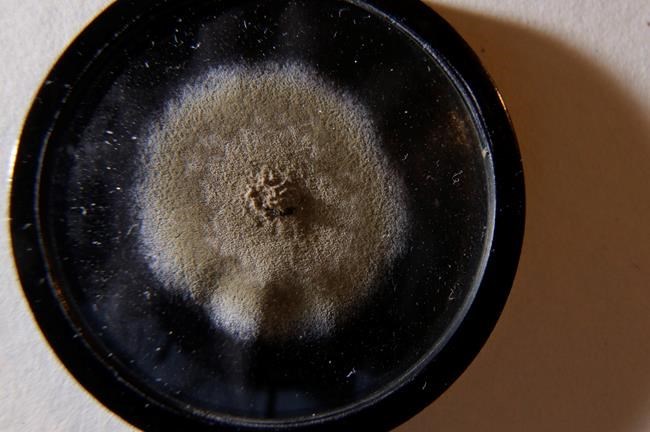
In this photo taken on Thursday, Feb. 16, 2017, a capsule of original penicillin mold from which Alexander Fleming made the drug known as penicillin on view at Bonham's auction house in London. The international auction house Bonham’s says it has sold a small, patchy disc of mold for $14,597. The off-white, nearly 90-year-old swatch of microbes has a rather extraordinary history: it was first created by Alexander Fleming to make penicillin, a revolutionary discovery that brought the world its first antibiotic. Bonham’s sold the mold Wednesday, March 1 during an auction in London. The germs are preserved in a glass case and feature an inscription by Fleming on the back, identifying it as “the mould that first made penicillin.” (AP Photo/Alastair Grant)
Republished March 01, 2017 - 10:47 AM
Original Publication Date March 01, 2017 - 6:45 AM
LONDON - How much is an old, dried out piece of mould worth? Apparently more than $14,600 if it was created by the doctor who discovered penicillin.
The nearly 90-year-old swatch of mould has a rather extraordinary history: It came from the laboratory of Dr. Alexander Fleming whose revolutionary discovery brought the world its first antibiotic, credited with saving millions of lives worldwide.
The patchy bit of mould from his niece's collection was auctioned in London on Wednesday for 11,875 pounds ($14,617). The buyer was not identified.
The mould is preserved in a round glass case and features an inscription by Fleming on the back, describing it as "the mould that first made penicillin."
That, however, may be a stretch. The Scottish-born doctor likely made at least dozens of such mould mementos, derived from his original sample of the fungus.
Fleming "sent these samples out to dignitaries and to people in the scientific world, almost as a kind of holy relic," said Matthew Haley, director of books and manuscripts at the auction house Bonham's.
He noted that other bits of mould were given to Pope Pius XII, Winston Churchill and Marlene Dietrich, perhaps in an effort to cement Fleming's legacy as the discoverer of penicillin in 1928.
Before the discovery, infections like pneumonia and rheumatic fever were near death-sentences.
"When it first became available, penicillin was called a miracle drug," said Kevin Brown, archivist at the Alexander Fleming Laboratory Museum . "Its discovery began a new, life-saving era in medicine."
In some ways, the discovery was accidental. Fleming found mould growing in an experiment when he returned to his cramped lab after a stay at his country house. One petri dish was full of bacteria except for an area where mould was growing. He later realized the mould — a rare strain of penicillin — was killing off the bacteria around it.
"Fleming noticed something that other people would have missed and saw the potential of penicillin to treat patients," said Brown.
Scientists at Oxford University further developed penicillin, and production was ramped up so that enough of the antibiotic would be available for the Allied invasion on D-Day in 1944. Fleming and Oxford scientists Ernst Boris Chain and Howard Walter Florey were awarded the Nobel Prize in medicine in 1945.
Brown noted that not everybody was thrilled to receive the preserved mould medallions and that some got multiple copies, including Queen Elizabeth's husband, Prince Philip.
"Every time he met Fleming, he got another one of these things," Brown said.
News from © The Associated Press, 2017